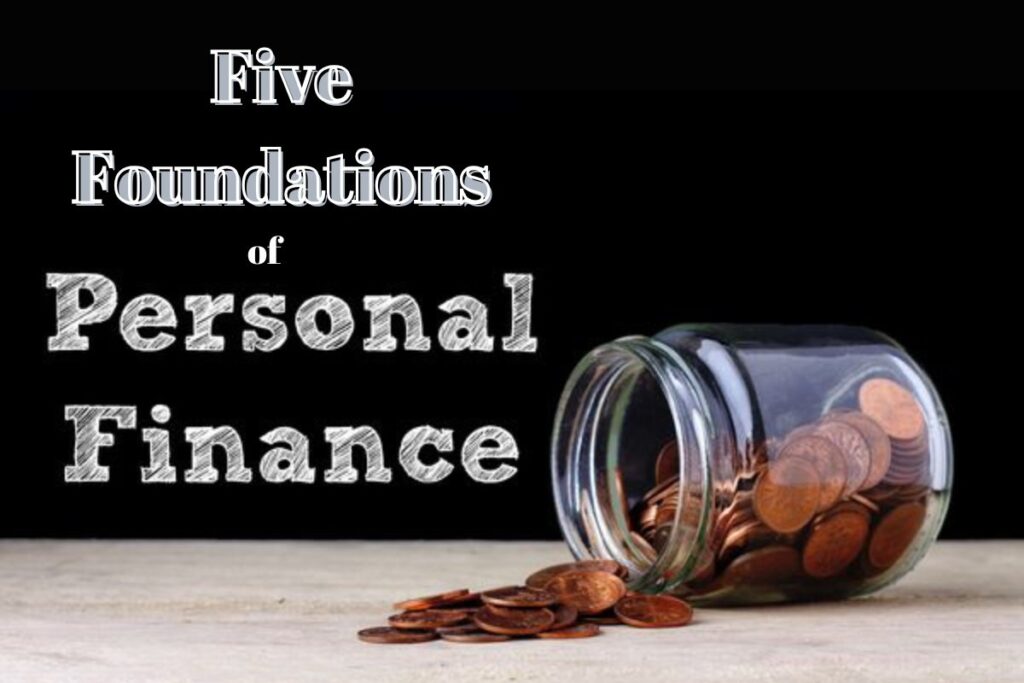Personal finance is all about making smart financial decisions to set yourself up for future success. It’s not just about budgeting or paying off your debt; it’s about building a solid financial foundation that will sustain you throughout your life.
The 5 foundations of personal finance provide a step-by-step guide for anyone looking to improve their financial health, whether you’re just starting out or want to improve your financial strategy.
In this guide, we’ll walk you through each of the 5 foundations of personal finance designed by Ramsey Solutions, a leading name in financial education spearheaded by Dave Ramsey.
How the Five Foundations of Personal Finance Can Set You Up for Future Success
The 5 foundations of personal finance are a simple yet powerful method for managing your finances. They are typically introduced in financial education programs for young adults, but their concepts are just as important for anyone at any stage. The five foundations in order are:
- Save a $500 Emergency Fund
- Pay Off of Debt
- Pay Cash for Your Car
- Pay Cash for College
- Build Wealth and Give Back
These steps might seem basic, but they create the foundation for financial security. Each of these steps prepares you for the next, helping you to avoid common financial mistakes and build a future of economic freedom. Now, let’s discuss each foundation and how to apply them.
1. Start an Emergency Fund With $500
The first step of the five foundations to personal finance is to consider starting an emergency fund with at least $500. This might not sound like much, but it’s enough to cover most unexpected expenses, like car repairs or medical bills. Setting aside this money will prevent you from going into debt when the unexpected happens.

This emergency fund is vital to developing financial stability, a habit that will serve you well in the long run. So, how do you go about setting up this emergency fund?
Here are a few simple steps:
- Eat at home. Eating at home is less expensive than eating out.
- Analyze your spending habits and look for areas to reduce unnecessary spending.
- Instead of getting an Uber or driving your car, take public transportation or ride a bicycle.
- Contribute to your emergency fund with bonuses or tax refunds.
- Automate your savings.
- Once you hit the $500 mark, your goal should be to continue growing your emergency fund to cover three to six months’ living expenses.
2. Pay Off Your Debt
Debt is one of the most significant drawbacks to financial freedom because it reduces your income and makes it more difficult to save or invest. Whether credit card debt, a car loan, or a student loan, debt prevents you from using your money the way you want.

To tackle your debt, make a list of everything you owe. Then, consider using the debt snowball method, a popular strategy where you pay off your smallest debt first while making minimum payments on the remaining debts. Once the smallest debt is paid off, move on to the next one. This gives you some level of financial confidence.
3. Pay Cash for Your Car
The third step is to pay cash for your car. Financing a car might seem normal but often leads to more debt and financial stress. The goal here is to save enough money to buy a car outright without the need for a car loan.
Cars are expensive and lose their value over time, making it impractical to take out a loan to buy something that will depreciate. But by paying cash, you can avoid interest payments and free up your income for other financial goals.

Tips on How to Pay Cash for Your Car:
- Budgeting will help you determine how much you need for a reliable car and set a target date for when you’ll have saved enough.
- Buying a used car instead of a new one will be significantly cheaper and won’t depreciate as quickly.
- If your current vehicle is still running, you can keep driving it as long as possible while saving up for the next one.
ALSO READ: 6 Mistakes You Should Avoid When Selecting a Personal Financial Planner
4. Pay Cash for College
Student loans are a common burden for many people, but the fourth foundation encourages paying cash for college. This doesn’t necessarily mean paying the full amount all at once; it’s about finding ways to reduce or eliminate the need for loans through scholarships, part-time work, or attending a more affordable school.

How to Pay for College with Cash:
- Start saving for college as early as possible. Even if you can save a small amount regularly, the power of compounding can help it grow over time.
- To reduce costs, consider attending a community college for the first two years and then transferring to a four-year institution.
- Devote time during high school to search for and apply for scholarships, grants, and work-study opportunities.
- Working part-time can help cover costs without accumulating debt.
While it may not be possible for everyone to graduate debt-free, the goal is to reduce student loan debt as much as possible so that you do not start your career burdened by debt.
5. Build Wealth and Give Back
The final foundation is about building wealth and giving back to others. Once you’ve saved an emergency fund, tackled debt management, and avoided taking on more debt for things like cars and college, you’re in an excellent position to start building wealth. This is the point at which investing becomes relevant.
Investing your money in the stock market, real estate, or retirement accounts can grow your money over time. Building wealth isn’t just about accumulating money—it’s about creating a life where you have financial freedom and can help others.

How to Start Building Wealth:
- Invest in retirement accounts by opening an IRA or contributing to your 401(k).
- Diversify your investments across different types of assets to reduce risk and grow your wealth.
- Work with a financial advisor who can help you create a personalized plan for building and preserving wealth.
It is important to give back to others to make a positive impact on your community while creating a legacy of generosity. This could be through charitable donations, volunteering, or mentoring others.
By following the five foundations of personal finance, you create a path toward financial freedom that prioritizes security, smart decision-making, and long-term wealth building.
As you implement these foundations, you’ll also develop a mindset that prioritizes personal finance for kids, teaching the next generation the value of smart money management. Most importantly, sticking to these principles ensures you’re not just getting by, but you’re setting yourself up for a prosperous, debt-free future.

